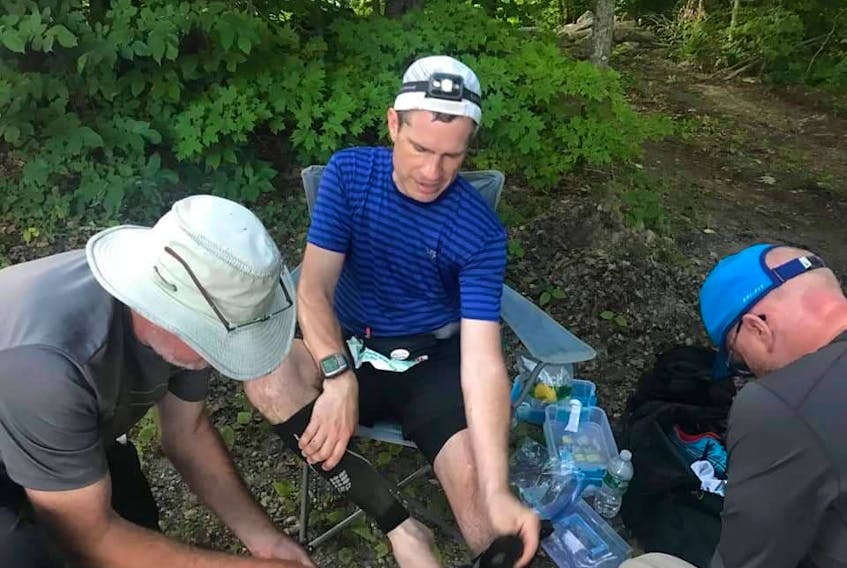AMHERST, N.S. — Running 160 kilometres over 20-plus hours is not something most people do.
It’s something Anthony Fromm accomplished last summer in Vermont and attempt to repeat Aug. 17 and 18 during Capes 100.
Pegged as the first 100-miler in Atlantic Canada, the event will feature runners traversing some of the tallest cliffs in mainland Nova Scotia and along the world’s highest tides beginning at Spencer’s Island and running around Cape d’Or, through Cape Chignecto Provincial Park and Eatonville.
It’s also some of the roughest terrain in Cumberland County.
“It’s going to be grueling, that’s for sure,” said the 45-year-old Fromm, a veteran runner and a member of the Amherst Striders Running Club. “It won’t have the elevation of Vermont, but it’s going to have some pretty challenging terrain. It could be pretty daunting.”
Last year, at the Vermont 100, Fromm set a goal of finishing the event in 24 hours and was “over the moon” to come in at just under 22 (21:56.24), which was 54th out of 207 male competitors.
This year, he’s hoping to improve upon that and has spent hours preparing out on the road.
He believes he is as physically prepared as he can be. Now he has to focus on the mental part.
“It can be difficult and there will be some low points. You just have to battle through those and keep going,” he said.
The race features three different distances and four events. There are runs of 50 kilometres and 100 kilometres with vertical climbs of 1,400 and 3,300 metres respectively while the 160 kilometre event will have a climb of 4,500 metres.
There is also a 160-k relay.
All the events must be completed with 36 hours.
Along the way are aid stations that will include things like water, cola, ginger ale and electrolyte drinks as well as sugary snacks like gummies and M&Ms, jerky and fruit like bananas and watermelon.
Also, from the 86-k distance to the end of the 100 and 160-K events there will be warm food through the night including soups and broth and grilled cheese sandwiches.
Participants are expected to have bottles, flasks or reservoirs to carry water, a waterproof jacket, a basic first aid kit, food and drink, a whistle, charged cell phone, headlamp with charged batteries (since some of the event is at night), gloves, toque/hat, sunscreen, a course map, lighter/matches and knife.
While it is a running event, Fromm said it’s not all running. In some areas, where the terrain is rougher and higher, it’s more like hiking while there will be opportunities at the aid stations to rest for a short time before resuming the race.
“It’s whatever you can do. In Vermont, there were a lot of big hills so I walked those and ran downhill and along the flatter terrain,” he said. “When you get to an aid station, you can take five to 10 minutes to get some food and water and get going again.”
He expects Capes 100 to include some single-trail paths as well as ATV trails and logging roads, especially in more remote areas.
“It’s not overly technical, but it will feature the biggest climbs when you’re the most tired,” Fromm said. “That’s going to be the most challenging part of this. That’s going to be tough.”
Fromm said 100-mile events are very popular around the world. He decided a little more than a year ago that he wanted to compete in one and Vermont’s was the closest. Now, he’s looking forward to doing one in his own backyard.
Hopefully, he’ll get to do one further afield, but said they are more difficult to enter because they use a lottery system.
One hundred-milers, like Capes 100, are very popular, so popular that they fill up within hours of registration opening.
Jodi Isenor of St. Margaret’s Bay-based NS Trail Running has been organizing races since 1995, including relay races, orienteering races, 24-hour adventure races and ultra-marathons.
Registration for Capes 100 opened last Aug. 1 and was sold out in just over two weeks.
“My wife and I have been directing races in Nova Scotia since 2010 and I’ve been organizing races of various types since 1995,” he said. “The longest race we’ve had up to this point was a potential 100-miler, but it was an elimination style event at Five Islands Provincial Park. That was a different format.
“People seem to be getting more into the longer distances. We have some friends in Spencer’s Island and we collaborated and decided to give it a go there.”
He said Capes 100 would be average to above average in difficulty in comparison to similar events elsewhere.
Isenor said Capes 100 is popular because it’s a destination-type race in that people can plan their vacations around it. He said participants are coming from as far as India and Germany as well as the United States and Canada.
There will be approximately 350 participants.
“Most times you know who’s showing up and who’s probably going to be in your top three. This race, we don’t really know. There are 200 people we have no idea are that are coming from overseas. We have no idea who’s going to win,” Isenor said.
He said there are a lot of volunteers participating, staffing the aid stations and other requirements. He’s hoping to have at least 75 volunteers in place before race day.









